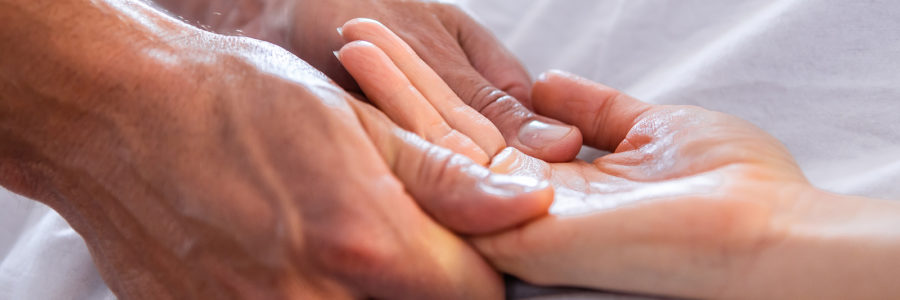 Massage therapy is an effect treatment for carpal tunnel syndrome. Carpal tunnel syndrome is a condition caused by a pinched median nerve in the wrist. It’s associated with pain, tingling, numbness, or weakness in the hand and wrist. The carpal tunnel is a narrow canal in the wrist. The bottom and sides of the tunnel are formed by small bones called carpal bones. The top of the tunnel is a strong band of transverse carpal ligament, which holds the all components together.
Massage therapy is an effect treatment for carpal tunnel syndrome. Carpal tunnel syndrome is a condition caused by a pinched median nerve in the wrist. It’s associated with pain, tingling, numbness, or weakness in the hand and wrist. The carpal tunnel is a narrow canal in the wrist. The bottom and sides of the tunnel are formed by small bones called carpal bones. The top of the tunnel is a strong band of transverse carpal ligament, which holds the all components together.
Inside the tunnel are the median nerve and tendons. Tendons are rope-like structures that connect bones in the hand to muscles in the forearm. They also allow the thumb and fingers to bend. The median nerve runs down the arm and forearm and passes through the carpal tunnel into the palm of the hand. It provides sensation to the fingers (except the little finger). It also adds strength to some small muscles at the base of the thumb and index finger.
When the ligament thickens or tendons swell, the space in the tunnel decreases and the median nerve becomes compressed, exerting excessive pressure on the median nerve.
Symptoms of Carpal Tunnel Syndrome
Carpal tunnel syndrome symptoms include:
- Tingling, burning, or itching in the palm and fingers, especially the thumb, middle, and index fingers
- Occasional shock-like sensation that moves up into the fingers
- Pain and tingling traveling up the forearm toward the shoulder
- A swollen feeling in the fingers
- Decreased feeling in the fingertips
- Occasional hand weakness and loss of coordination
- Weakness and clumsiness in the hand, which may make it difficult to use the hand for small tasks such as writing, or buttoning a shirt
- Dropping objects due to numbness, weakness, or loss of proprioception
Symptoms of carpal tunnel syndrome begin suddenly or gradually- without a specific injury. In fact, many people find that symptoms come and go at first, and usually affected by excessive use of the hand. As the condition worsens and the pressure on the nerve becomes greater, symptoms may become more frequent or may persist for longer periods of time.
It’s common for people to experience nighttime symptoms because many sleep with their wrists bent. In the morning, a person may wake up with tingling or numbness in their hands. They may not notice the problem at all during the day, but symptoms often flare up when holding something with the wrist bent, such as when reading a book, using a phone, or driving. Many patients find that moving or shaking the hands can relieve the symptoms in the early stages of the condition.
Causes of Carpal Tunnel Syndrome
Carpal tunnel syndrome is often caused by a combination of factors that irritate or squeeze the median nerve. Possible contributing factors include:
- Activities that involve highly repetitive wrist or finger motions, like typing, farming, or knitting. Repetitive motions may aggravate the tendons in the wrist, causing swelling that exerts pressure on the nerve. This usually happens when the hands are lower than the wrists
- Trauma or injury to the wrist, such as sprain or fracture. This may break one or more of the carpal bones, cause swelling, or deform the small bones in the wrist
- Arthritis-related diseases, especially if there is swelling of the wrist joint, tendons, and tissues in the carpal tunnel
- Work that involves heavy use of the wrist
- Mechanical problems in the wrist joint
- Hormonal changes and fluid retention caused by pregnancy or menopause
- Repeated use of vibrating hand tools or instruments that require forceful gripping and put pressure at the base of the palm
- Heredity
- Health conditions such as diabetes, amyloidosis, kidney failure, lymphedema, menopause, an underactive thyroid gland, or an overactive pituitary gland
Massage Therapy for Carpal Tunnel Syndrome
Massage therapy is a non-invasive and effective treatment for carpal tunnel syndrome. It helps relieve the symptoms of carpal tunnel syndrome by reducing swelling in the muscles caused by damage or overextension in the work environment. It also works by breaking down scar tissue, and softening and lengthening muscles and fascia of the shoulder, neck, elbow, wrist, hand, forearm, and upper arm.
During a massage session, the therapist will use deep tissue work to stimulate trigger points, release adhesions, and reduce the tension in the soft tissues of the arm, shoulder, hand, and wrist. This involves bringing the arm and shoulder out of internal rotation or incorporating myofascial cupping to reduce muscle tension.
By massaging and stretching tendons in the arm and wrist, a massage therapist can help restore full flexibility of the arm and reduce the pressure the tendons are putting on the median nerve. This in turn reduces the inflammation, pain, and numbness associated with carpal tunnel syndrome.
The number of massage sessions it takes for a patient with carpal tunnel syndrome to find relief will vary depending on how severe the problem is. Most clients experience some level of relief after the first session but for others, it may take three to five sessions or more to get long-term results.
Learn Advanced Massage Therapy Techniques from the Experts
While massage therapy is effective in treating carpal tunnel syndrome, it must be done right to get the expected results. If you’d like to expand your knowledge and skills in massage therapy, enroll in one of Seattle’s best massage therapy schools to learn therapeutic massage therapy protocols. You’ll learn massage theories and practices, anatomy and physiology, pathology, kinesiology, and much more. This will equip you with the skills you’ll need to provide care for individuals who’ve been affected by carpal tunnel syndrome and other similar ailments.
Another option for massage therapy schools in Seattle is our sister school Seattle Clinical Massage School
Contact us today to speak with one of our enrollment specialists.

IT Band Syndrome

Did you know that engaging in activities that involve repetitive flexing and extending of knees can cause iliotibial band syndrome? Well, studies show that walking long distances, cycling and athletics, among others are some of the contributing factors. As a nurse, physical therapist, fitness coach or yoga instructor, you will always encounter clients with IT band injuries. According to experts, incorporating massage therapy with conventional treatment is one of the best approaches to manage IT band syndrome.
What Is IT Band Syndrome?
The IT band is a thick connective tissue that originates from the pelvic bone and extends laterally to the shinbone. The fibrous band works with hip muscles to stabilize lateral movements of the hip and knee. However, overworking the connective tissue with activities that require repetitive knee flexion and extension causes IT band syndrome. The overuse movements create friction between the band and the lateral femoral epicondyle, thus, causing discomfort when exercising, or moving. Signs and symptoms of IT band syndrome include:
- Patient reports feeling an irritating pain along the lateral side of the hip and the femoral epicondyle during motion.
- There is notable inflammation and swelling on the outer part of the knee.
- Slight pain is felt at the beginning of an exercise and increases with intensity as the activity progresses.
- Pain in the gluteal region caused by overstretching gluteus muscles.
- Experiencing a popping pain that results from the rubbing of IT band against your knee during movement.
- Tenderness on the lateral femoral and tibia epicondyles upon palpation
Diagnosing the IT Band Syndrome
Despite causing knee pain, iliotibial band syndrome is not the only cause of knee discomfort. Before making your diagnosis, ensure you take a history of the client’s complaints and their daily activities. Usually, the iliotibial band syndrome affects people who engage in activities that put a constant strain on the knees. A client who reports being a runner, bicyclist, hiker or athlete might be a candidate of iliotibial band syndrome.
After taking the history, the next essential step is to conduct a comprehensive physical assessment to determine the precise effected location. You can use some tests such as Noble’s test to assess for pain in the lateral femoral condyle. Additionally, using an Ober’s test will assist you in examining the IT band for tightness. A comprehensive physical examination will give you an insight on areas that need massage therapy; to determine the appropriate techniques for myofascial release.
Managing IT Band Contracture Syndrome with Massage Therapy
As a professional health worker, ensure that massage therapy is in your to-do interventions for iliotibial band syndrome. Offering a massage along with traditional treatment has proved to be effective in enhancing recovery from the IT band syndrome. Below are the benefits of massaging your patients:
- Relieve Lateral Leg Pain
In most cases, it’s a nagging pain resulting from IT band overuse that forces patients to seek professional intervention. Performing myofascial release massage on the lateral side of the effected leg relaxes the fibrous band and muscles from tension — thus alleviating the pain.
- Promote Healing
Nowadays, unique massage techniques aim to not only relieve pain but also to promote tissue healing. Addressing trigger points and hypertonicities of the leg muscles enhances blood circulation. Improved tissue perfusion allows delivery of oxygen and nutrients to enhance the healing of the injured tissues.
- Restore flexibility and Improve Mobility
A patient who is suffering from IT band syndrome often complains of inability to move comfortably. Massage therapy resolves muscle stiffness and tenderness, therefore refining motion and flexibility. Therefore, after several sessions, your patient will be able to resume daily activities with ease.
- Improve Posture
When the pain is intense, most people adopt bad postures in response to the discomfort. As a massage therapist, you are equipped with unique skills to resolve tension and inflammation of the effected regions. The relaxation and flexibility of the leg enable the patients to assume their normal and healthy posture.
- Alleviate Stress and Anxiety
Besides enhancing physical fitness, massage treatment helps to relieve the body from stress. Reduced anxiety in patients with IT band syndrome promotes healing and improves their emotional well-being.
What is the prognosis of Iliotibial Band Syndrome?
Typically, if you utilize the right treatment modalities, the prognosis of IT band friction syndrome is excellent. For optimum results, it is crucial to use a multifaceted approach when treating patients. Whether you are a nurse, physical therapist, or a fitness coach, integrating massage therapy with conventional treatment will yield a positive outcome.
Ultimately, adding massage therapy to your healthcare profession not only improves healthcare delivery to your clients but also makes you indispensable. Want to learn more about managing IT band syndrome with massage therapy? Contact our Seattle massage therapy schools today to discuss your massage career and educational options in Seattle, Tacoma, or Bellingham.
I addition you can also contact our partner massage therapy school; Seattle Clinical Massage School for information about a massage therapy career in Seattle, Washington.





